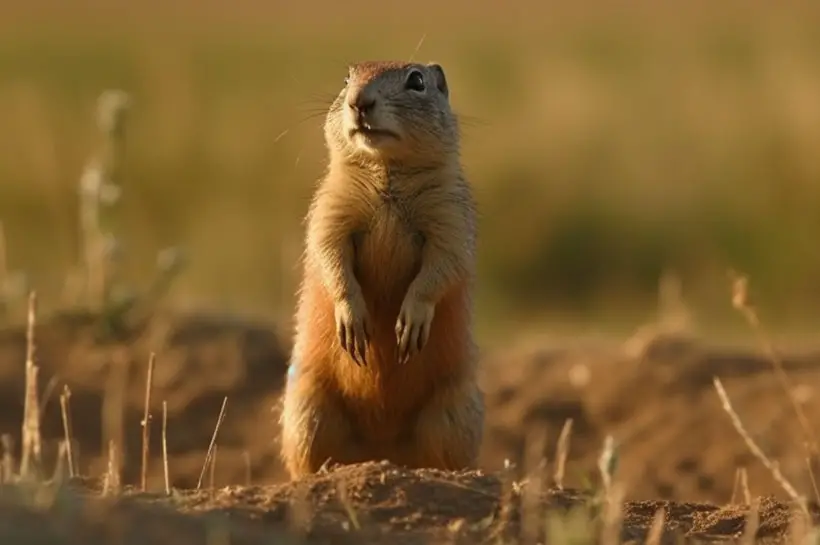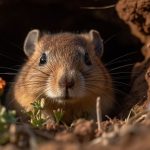How Big Is a Gopher Compared to Other Animals? A Guide to Identifying Gopher Size and Physical Characteristics
Gophers are social animals that live in extensive burrow systems. They are known for their remarkable digging abilities and can construct complex tunnels that can span up to 200 yards. Gophers feed on roots, tubers, and other underground vegetation and store their food in underground chambers.
With their unique physical adaptations, gophers are well-suited for life underground and play an important role in many ecosystems. Understanding the size and physical characteristics of gophers compared to other animals is important for several reasons.
- Firstly, gophers are known to cause significant damage to crops and landscaping, making them garden pests. Knowing how to identify gophers and their size can aid in pest prevention and control of their damage.
- Secondly, gophers are an essential food source for many predators, such as owls, hawks, and foxes. Understanding the size and physical characteristics of gophers can help these predators target their prey and maintain a healthy ecosystem.
So, how big is a gopher compared to other animals? When compared to other animals, gophers are almost similar in size to rats but smaller than squirrels and skunks generally. However, they are larger than voles and moles. Besides, they have distinct physical characteristics compared to other similar burrowing animals.
In this article, we will explore the size and physical characteristics of gophers compared to other animals. Moreover, we will discuss how to identify gopher size and unique physical adaptations that allow them to survive underground.
Gopher Size and Physical Characteristics
Understanding the physical characteristics and size of gophers is crucial to comprehend how they compare to other animals. So, let’s delve into them and also the unique physical adaptations that allow them to survive underground.

Description of the Average Size and Weight of Gophers
Gophers are small to medium-sized animals belonging to the rodent family. They range in size from 6 to 8 inches long in the body, depending on the species. The weight of a gopher varies depending on its species and sex. Typically, males weigh slightly more than females.
It is important to note that the size ratios of gophers can also vary depending on the region they inhabit. Here are some examples of different gopher species comparison according to average size and weight:
- Botta’s Pocket Gophers: These gophers are found in the western United States and Mexico. They measure 7.1 to 10.6 inches long. Males weigh between 5.6 to 8.8 ounces and females weigh between 4.2 to 7.1 ounces.
- Northern Pocket Gophers: These gophers are found in Canada and the northern United States. They are smaller than Botta’s pocket gophers on average, measuring from 6.5 to 10 inches long and weighing from 2 to 5.5 ounces.
Comparison of Gophers’ Physical Characteristics to Other Animals

Gophers are often compared to other burrowing animals such as rabbits, groundhogs, and moles.
- Like rabbits, gophers have strong hind legs that are adapted for digging and hopping. However, gophers have smaller ears and shorter tails compared to rabbits.
- Gophers also have short, stocky bodies that are well-suited for life underground. In comparison, groundhogs are larger and have more elongated bodies.
- Moles, another burrowing animal, have long, pointed snouts and webbed front feet, unlike gophers.
Discussion of Unique Physical Adaptations of Gophers
Gophers have several unique physical adaptations that allow them to thrive underground.
- Their front paws are broad and shovel-shaped, with long claws that are ideal for digging through soil.
- Gophers also have sharp, constantly growing incisors that allow them to gnaw through roots and tubers.
- They have a sensitive sense of touch in their whiskers, allowing them to navigate the dark.
- Gophers also have a highly developed sense of smell, which helps them detect predators and locate food.
- To prevent dirt from entering their nostrils while digging, gophers can close their nostrils and hold their breath for several minutes.
- Gophers have pouches in their cheeks that allow them to carry food and nesting materials while digging.
- Their fur is thick and velvety, providing insulation and protection from soil abrasions.
In addition to their physical adaptations, gophers also have unique behavioral adaptations that help them survive underground, such as:
- Hoarding food: Gophers are known for hoarding food in their burrows, which helps them survive during food scarcity.
- Creating multiple burrow systems: Gophers create multiple burrow systems that are connected by tunnels. This allows them to escape predators and move between different food sources.
Identifying Gopher Size
Gophers come in different sizes, and identifying their size can be helpful for various reasons, such as determining their age or species. So, let’s dig deep into some tips for identifying their size and the differences between gopher sizes and other similar animal sizes.

Body Measurements
One of the easiest ways to identify gopher size is through physical measurements. They can be identified by their small size and stocky build.
And to accurately measure the size of a gopher, measure from the tip of the nose to the base of the tail. Different species of gophers can have varying sizes, so it is important to be familiar with the species in your area.
Visual Cues
Visual cues can also help identify gopher size. For example, the size of a gopher’s head and eyes can provide insight into its size. Larger gophers will have larger heads and eyes compared to smaller ones.
The size of their front teeth can also be an indicator of their size, as larger gophers will have larger teeth.
Differences between Gopher Sizes and Other Similar Animal Sizes
It can be challenging to differentiate between gopher sizes and other similar animal sizes, such as voles or moles. However, some notable differences can help.
Voles, also known as meadow mice are smaller than gophers and have shorter, rounder bodies. They also have smaller eyes and ears compared to gophers.
Moles, on the other hand, have a cylindrical body, a hairless snout, and small eyes and ears. They are also smaller than gophers, with an average length of 4 to 6 inches.
Gopher Size Chart
One useful tool for identification is the gopher size chart. Hence, a discussion on where to find size charts and how to interpret them is necessary.

Where to Find Gopher Size Charts
Gopher size charts can be found online or in wildlife research studies. Many wildlife organizations and government agencies publish size charts and diagrams as part of their educational resources. A simple online search can yield many results.
For example, the National Wildlife Federation has a page on pocket gophers that includes information on their size and habitat. Trutech Wildlife Removal also has a page on gophers that includes information on their size and characteristics.
Additionally, some scientific journals also publish research articles that include size charts and diagrams.
For instance, you can see how a gopher’s burrow system is structured and enlarged in this diagram.

Interpreting Gopher Size Charts
Gopher size charts typically include size metrics of body length, tail length, and weight. These measurements can be used to identify different species and sizes of gophers.
For example, pocket gophers are generally smaller than ground squirrels and have shorter tails. Understanding the differences in measurements can help in identifying the species.
Using Gopher Size Charts For Identification
To use a gopher size chart for identification, it is important to first determine the measurements of the gopher in question. Measurements can be taken using a ruler or measuring tape.
Once the measurements have been taken, they can be compared to the size chart to identify the species and size of the gopher.
How Big Is A Gopher Compared To Other Animals?
While gophers are often mistaken for moles or voles, they have distinct physical characteristics that set them apart from other animals.

A gopher size comparison to other rodents and other common backyard pests and wildlife can be handy in distinguishing them. Especially, a comparison with similar animals like squirrels, rats, and skunks.
Gopher Size Compared to Squirrels
Gophers are typically smaller than squirrels, with an average weight of around 200 grams. Squirrels, on the other hand, can weigh up to 8 kilograms. Gophers are also more compact and have shorter limbs than squirrels.
This size difference affects their behavior and habitat. Gophers are better adapted to burrowing underground. On the contrary, squirrels are better suited for climbing trees and running along branches.
Gopher Size Compared to Rats
Rats and gophers are similar in size, with both animals weighing around 200 grams on average. However, rats are more slender and have longer tails than gophers. This difference in body shape affects their behavior and interactions with other animals.
Gophers are more likely to burrow underground and stay close to their burrow system. On the other hand, rats are more likely to climb and explore their surroundings.
Gopher Size Compared to Skunks
Skunks are much larger than gophers, with an average weight of around 4 kilograms. This size difference makes skunks less vulnerable to predation and allows them to defend themselves with their powerful spray.

Gophers, on the other hand, are more vulnerable to predation and must rely on their burrowing abilities to escape danger.
Effects of Gopher Size on Behavior, Habitat, and Interactions with Other Animals
Gopher size has a significant impact on their behavior, habitat, and interactions with other animals.
- Their small size makes them vulnerable to predators such as birds of prey, snakes, and coyotes.
- This vulnerability affects their burrowing behavior. That’s because they must constantly be on the lookout for predators and adjust their burrow systems accordingly.
- Gophers are also more likely to interact with other burrowing animals such as moles and voles, because they share similar habitats and food sources.
FAQs
Here are some additional related questions and their answers.
Q. How do gophers’ physical characteristics help them to survive underground?
Gophers have physical characteristics that aid their survival underground. Their strong front legs equipped with sharp claws facilitate efficient digging. The small eyes and ears, along with sensitive whiskers, allow them to detect predators and prey and navigate in the dark tunnels.
Additionally, their specialized teeth and digestive system allow them to feed on tough plant material found underground.
Q. How do gopher sizes vary between different species?
The size of gophers varies depending on genetics, environment, and diet. Different species have adapted to different ecological niches resulting in varying body shapes and sizes.
A small species like the Wyoming pocket gopher has adapted to living in environments with lower food availability and more competition for resources. They have a more compact body shape and shorter limbs. This allows them to move more efficiently through their burrow systems and conserve energy.
A larger species, like the Plains pocket gopher, has evolved to live in more open environments. Because there they must travel long distances to find food and mates.
Conclusion
In conclusion, this article has covered the size and physical characteristics of gophers compared to other animals. It has also covered tips for identifying gopher size, and unique physical adaptations that help gophers survive underground. They have physical and behavioral adaptations that allow them to survive underground. Identifying their size can be done through physical measurements and visual cues.
A gopher size chart can also be used for identification, and it can be found online or in wildlife research studies. Other similar animals such as voles and moles can be distinguished from gophers by their physical characteristics. Understanding gopher size and physical characteristics is important for pest control companies and wildlife management agencies. By familiarizing with animal anatomy like gophers, damage to crops and landscaping can be better controlled.
Moreover, we can support a healthy ecosystem for predators that rely on gophers as a food source. Further research on gopher anatomy and behavior can provide valuable insights into their ecosystem roles. Furthermore, it can aid in the development of effective management strategies.




